► Ioniq 5 N vs Model 3 Performance
► Old-school charm, or futuristic tech?
► Hot EVs battle for supremacy
Tesla’s new Model 3 Performance takes on our favourite hot EV, the Hyundai Ioniq 5 N. Can there really be two thrillingly good electric family cars?
Pre-flight briefing: Hyundai Ionia 5 N

Why is it here?
Hyundai’s transformation from worthy but dull to worth-BMW-money came into full bloom with the Ioniq 5, an electric crossover that looks like a supersized VW Golf and shares many of its underpinnings with the similarly impressive Kia EV6. The Giugiaro-esque styling, which nods to Hyundai’s own ’70s Pony, still looks fresh. Non-N cars have recently been facelifted, but it’s not a big deal. Interior space is vast and the N model has almost four times the muscle of the base car.
Any clever stuff?
All Ioniq 5s are capable of bi-directional charging and get 800-volt electrics for speedy 250kW fills. But the new N version’s real party piece is its simulated manual transmission. You can either drive it like a conventional EV for maximum performance or use the paddles to shift between eight fake gears for maximum involvement.
Which version is this?
The regular Ioniq 5 line-up starts at £43k for a humble single-motor, rear-wheel-drive model and stretches to £58k for a fully-loaded 322bhp dual-motor Namsan Edition. The financial stretch from there to the £65,000 N isn’t that big, but the performance gulf is huge thanks to a 641bhp powertrain that delivers 62mph in 3.4sec.
Read our Hyundai Ioniq 5 N review
Pre-flight briefing: Tesla Model 3 Performance
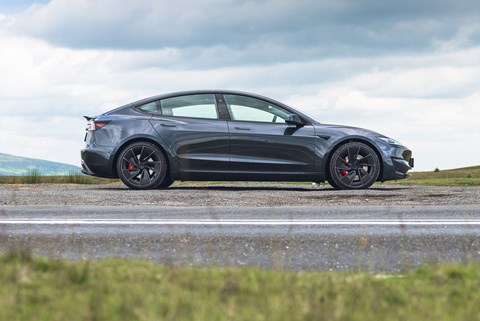
Why is it here?
The Model 3 made small EVs both desirable and affordable when it launched in 2017, but a slew of rivals have jumped into the arena since then so Tesla introduced a facelifted version, dubbed Highland, in late 2023. A new nose, better quality interior materials and controversial indicator controls mounted on the spokes of the steering wheel are the headlines.
Any clever stuff?
Rear-seat passengers get their own 8.0-inch display to control temperatures and watch Netflix, and drivers now have to shift between drive, reverse and neutral using an icon on the touchscreen (or the predictive shift feature). This range-topping Performance model gets a dedicated Track driving mode and drift option, giving drivers the scope to increase the understeer or oversteer.
Which version is this?
This is the most potent and most expensive Model 3, the £59,990 Performance, that can hit 62mph in 3.1sec. A less powerful Long Range Model gets a similar bi-motor, all-wheel-drive set-up for £49,990 and can still reach 62mph in 4.2sec, or there’s a single-motor, rear-drive version for £39,990. There’s no similarly hot version of the Model Y – a car that’s often described as a taller Model 3, but which lacks its agility.
Read our Tesla Model 3 Performance review
Hyundai Ionia 5 N vs Tesla Model 3 Performance: the test
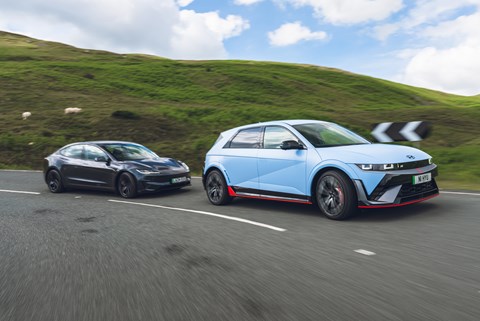
Suck, squeeze, bang, blow. Unleash the full motherlode in one of 2024’s obscenely fast EVs and that pithy description of a four-stroke combustion cycle feels like it’s been repurposed for the electric age, except it’s the driver doing the heavy breathing, not the car. It starts with a get-ready intake of breath and a here-goes-everything push on the right pedal, and ends with a dazed exhalation 200 metres down the road.
We all know that even some ordinary EVs have been able to embarrass supposedly rapid combustion-powered heroes away from the lights for years. But it’s only recently that car makers have begun to market fully-formed electric performance cars for the enthusiast market, and there are already some great hot EVs out there. Cars like the Ioniq 5 N – the car that came out top of the ‘EVs for Petrolheads’ shootout earlier in 2024, which here takes on the latest version of Tesla’s fastest small car, the Model 3 Performance.
This pair look like hatchbacks and accelerate like supercars, when they’re neither. With the i20 N and i30 N being eased out of the European market, the £65,000 Ioniq 5 N crossover signals a new electric focus for Hyundai’s performance sub-brand. And the Model 3 Performance is a £59,990 saloon that’s twice as rapid as the base car.
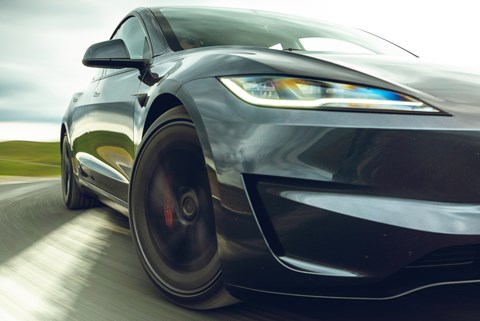
There’s been a 3 Performance on Tesla’s books since 2018, but beyond its ability to turn your internal organs into minute steak it never felt different enough from the already fast and longer-legged dual-motor variants to justify the additional expense. While some buyers probably love the stealthy presentation, most drivers thinking of jumping ship from a BMW M car or AMG expect more than simply NASA launch-grade acceleration. More visual attitude, more ego stroking from the interior appointments, tangible handling benefits. Recognisable and kudos-earning performance branding.
The new Model 3 flagship goes some way to answering those complaints. It’s still called Performance, rather then taking the Plaid name used by the naughtiest S and X models, meaning Tesla hasn’t yet united its fast cars under a common brand. But this time there are some helpful visual telltales.
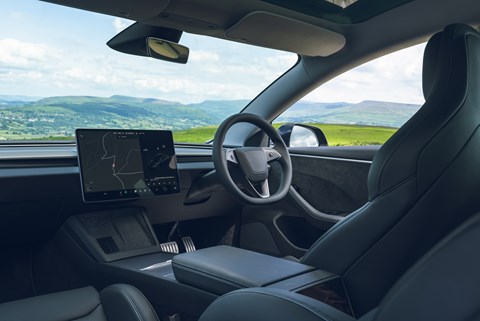
Like all new Highland-generation Model 3s, the 2024 Performance gets a pointier beak with slimmer headlights that make it look less cute and more cut-throat. But a bespoke front bumper with vents at each corner and a blacked-out lower section with a small splitter help distinguish it from the base and Long Range models.
Other clues include handsome 20-inch wheels with aero covers placed between the spokes rather than the 18s (and optional 19s) on the cheaper cars, bigger brakes with red calipers, and a confusingly Plaid-looking badge and neat little carbon lip spoiler on a bootlid that’s still crying out to be a hatch, and still isn’t.
Think of the Performance as a regular Model 3 viewed through one of those Snapchat filters that makes your skin subtly smoother and cheekbones more chiselled, rather than one that makes you look like you just got back from a fortnight in Istanbul where the doctor signed you up for everything on the menu.
No, the Ioniq isn’t subtle, the weird drain cover grille above the front bumper, trademark red N detail lines and in particular the huge and very shiny black plastic lower bumper section making it look like it was designed to appeal to six-year-olds.

But there’s a real sense of fun about the shouty go-faster styling add-ons that even big kids can get behind. And real substance to back it up. Compared with the regular Ioniq 5’s, the bodyshell is welded and glued for extra strength, the suspension subframes reinforced, the wider-track suspension has new arms, springs, adaptive dampers and bushes, and the steering rack is faster and fastened more securely.
The non-N line-up starts with a single electric motor and a feeble 168bhp, which can be upped to 225bhp via a long-range battery or transformed into a 321bhp dual-motor EV that hits 62mph in under 5.0 seconds. Not bad, while not being bad-ass enough to cut it as a performance car these days, so the N gets more electric ponies. An entire western’s worth.
A 223bhp front motor and 378bhp rear motor buddy-up to generate 601bhp, the kind of muscle that can snap your neck back hard when you floor the accelerator. And unlike less potent EVs, it maintains that push long after you think it’ll fade. Come up behind a cyclist or dawdling tractor on a country road – the kind of situation when you need to explode from 10 mph to 50mph in an instant, but never can, even in the fastest combustion cars – and when you nail the throttle the N won’t fail to win your over.
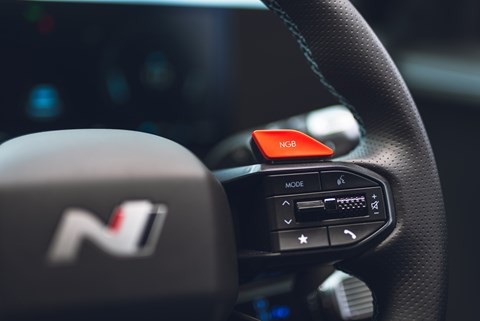
And we haven’t even got to THE RED BUTTON yet. Extend your right thumb to press the NGB (N Grin Boost) tab and you unlock an extra 40bhp for 10 seconds. There’s absolutely no occasion when you need it, but plenty when you’ll use it anyway, because it’s so addictive it makes a crack habit feel like a take-it-or-leave-it social smoking hobby.
Deploy the lot from rest and you’ll hit 62mph in only 3.4 seconds and the standing quarter mile in a hair over 11 seconds, a smidge of torque steer gently jiggling the wheel in your hands. That’s damn near McLaren F1 pace. But it’s still not enough to shake the Tesla off.
The mid-ranking dual-motor Model 3 stomps to 62mph in only 4.4sec, but the Performance drops the sprint time to 3.1 seconds with a powertrain that’s rated at 453bhp here but 510bhp in the same spec in the US. It seems unfathomable that its Model S Plaid big brother is almost 50 per cent quicker again.
But despite the potential to shock, the Performance is entirely capable of mooching along like a regular Model 3, with only the slightly fidgety ride and pleasing hug of the not-a-Plaid-branded sports seats in the sterile cabin reminding you that you’re not in a humble single-motor car. There’s almost no indication from the driver’s seat of what’ll happen when you dip into the power until you do, and in Chill mode even maximum acceleration is modest.
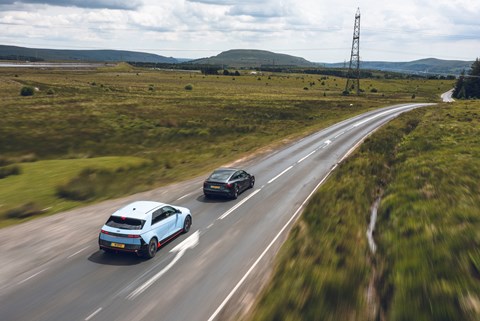
But Insane mode really is that, to the point where this morning’s breakfast starts making noises about planning to pull a U-turn. And that feeling of wanting to change direction really does follow through to the rest of the Tesla experience. It’s incredibly eager to turn into corners, but that comes at the expense of a slightly nervous feel that probably isn’t an issue on fast, smooth curves, but makes the 3 seem a little edgy on a bumpy B-road.
And it’s not the only trait that might make you think twice about opening the taps on a road without plenty of visibility ahead. It’s good to know that there’s decent regenerative braking power available, because while the trad brakes can haul the 3 up from huge speeds without breaking sweat, the pedal needs a big shove, and the feel doesn’t inspire confidence.
Iffy brake feel is nothing new in EVs and hybrids, which often struggle to blend the efforts of the motors and the old-fashioned friction-based stoppers. But the Hyundai nails it with brakes that have enough bite at a light push without feeling jumpy or inconsistent. They just feel right from the get-go.
And that’s the N all over. It fills you with confidence the moment you start to lean on it. You know, the way the best petrol-powered hatches do. It has tremendous straight-line stability, so much that it’s borderline inert at motorway speeds, but still manages to feel lively on twisty roads. Not as lively as the Tesla, but you’re thankful for that when you’re really exploring the right pedal’s arc, never knowing exactly what’s around the next corner that might force you to change your line.
Shame the steering doesn’t involve you in the action a little more clearly. It’s accurate and well weighted, and feels more natural than the Tesla’s, but you never get the sense that you’re keyed into the tarmac the way you do in the very best driver’s cars. And on narrow B-roads you never forget that the Ioniq 5 is 63mm wider than the Model 3. Seen in isolation it might not be obviously an SUV, but the girth and the 2235kg kerbweight (almost 400kg heavier than the Model 3) ensure it is.
As on the Model 3 Performance, you can tweak the Ioniq’s front-to-rear torque bias – though you never really shuffle the torque, only reduce it at one end to exaggerate the effect at the other – and the Hyundai lets you save your favourite powertrain and chassis configurations so that you can call them up whenever you want via a button on the lower left of the wheel.
That’s nothing new, but the button’s mirror image on the lower right of the wheel is. Press it and the Ioniq does its best impression of a petrol car, giving you eight pretend gears to play with, an imaginary 8000rpm revcounter and three different fake engine sounds to pick from, or the option to mute them altogether.
The idea of slogging up a hill in a pretend fourth gear, denying yourself the true push available, seems at first perverse – what next, an electronic choke lever for cold starts? – but it’s genius. We found ourselves flicking between EV and fake-engine modes depending on our mood, and far more often than we toggle between two- and all-wheel drive in an xDrive BMW M car. You can even blip the throttle in traffic. Those cheesy sound effects need work, mind, so you might be thankful for the mute option. Because it’s not only you that can hear them, but everyone outside, too. If we’re playing pretend petrols, then why not give us some genuine soundtracks, Hyundai? Maybe we could even download new ones from an app store that’s updated a few times a year.
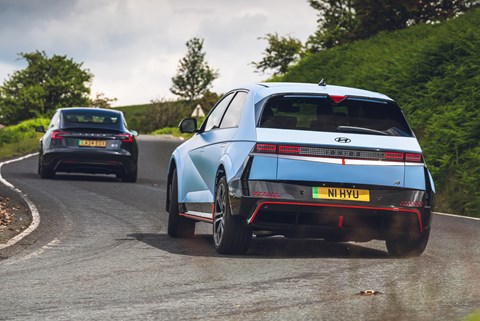
But even ignoring the driver toys, the Ioniq’s interior has plenty to offer. Much like the way the N moves down the road, there’s a reassuring familiarity about the controls that you don’t get in the Tesla. The 3 is blighted with terrible steering-wheel-mounted indicator controls (an enterprising third party already has a retrofit column stalk in development) and asks you to spend too much time looking at the centre screen, even simply to see how fast you’re going – a handy thing to know in a car this quick.
The Hyundai’s centre screen is, frustratingly, more of a stretch away, but the interface is well thought out, there are plenty of hard keys below and the already fine Ioniq’s interior is peppered with smart N details, including a fantastic set of seats to remind you where your money went even when you’re crawling through traffic.
Tall rear-seat passengers who find the reasonably roomy Tesla too tight will be delighted by the Hyundai – it’s huge back there. Although the Ioniq’s hatch opening gives it an advantage over the Tesla’s old-fashioned boot, the Model 3’s cargo area is bigger than the Hyundai’s, and the 5 N doesn’t have a frunk, unlike the Tesla, and unlike the non-N Ioniq 5, with its single rear motor.
That’s not the only practicality win the Tesla scores over its rival. The Performance has a 328-mile WLTP range, which is down from 390 miles for the £10k-cheaper bi-motor Long Range, but makes a mockery of the Hyundai’s 278-mile rating. And those are make-believe official numbers, remember. You’ll get at least 250 real miles out of the Model 3 but only 200 out of the Ioniq. And if you’re only filling to 80 per cent, budget for plenty of stops on longer journeys. Both cars can handle 250kW of charge, meaning stops are at least brief, if you can find suitable chargers, which is often easier for Model 3 drivers, thanks to the Supercharger network.
Hyundai Ioniq 5 N vs Tesla Model 3 Performance: the final reckoning

Imagine jumping back in time 20 years and telling your retro self that one of 2024’s hottest performance cars is an electric Hyundai that costs as much as a proper six-cylinder, rear-wheel-drive coupe from BMW’s M division (don’t say M2, which will be confusing). And the other is named after some long-dead Serbian inventor. Young you would think old you had lost a few marbles in the Time Tunnel.
But here in the present, we no longer bat an eyelid at that kind of thing. Hyundai and Tesla both have enough brand credibility and engineering know-how to create fast EVs that are exciting enough to make even some die-hard petrol fans think about switching sides.
Those drivers might have considered Tesla’s Model 3 Performance before, but the facelifted car is better in almost every way. It has more power, which it didn’t really need, and a better-quality interior and a stronger visual presence, which it did. Grip and body control are both tangibly better than before and Tesla has built in extra configurability of the handling and powertrain set-ups with additions including track and drift modes.
Realistically, you’ll almost never use those, or the similar features in the Ioniq 5 N, but we guarantee you’ll love the Hyundai’s simulated manual transmission and probably find yourself engaging it regularly. Because it makes the N fun in a way most EVs aren’t, which rely so heavily on their instant response to deliver thrills.
But even if you put the gadgety stuff to one side for a moment, the Ioniq 5 N still does the business. It’s way roomier and the interior delivers a ton more of that feelgood factor performance cars need. We’d happily trade the Model 3’s slight accelerative advantage for the Hyundai’s simpler control interface and more welcoming driving environment.
And when it comes down to it, the Ioniq delivers where it matters. It does feel wide, but it masks its weight well and gives you the stability and brake feel to let you explore everything the bi-motor drivetrain can throw at you. If you still don’t think EVs can cut it as rounded fast cars, this is the one that will change your mind.
There are at least three reasons why you might want to give the Tesla the nod. You might prefer its sleeper styling and you’ll definitely prefer its £5k cheaper sticker price and much longer (but still not long enough) driving range. But we’ll take the Hyundai, thanks – in black to dial down the styling, and paid for on a PCP, where it comes in cheaper than the Tesla. But we’ll do it with the knowledge that there are going to be days when that lack of range will drive us mad. We think it’ll be worth it.
Hyundai Ioniq 5 N vs Tesla Model 3 Performance: the verdict
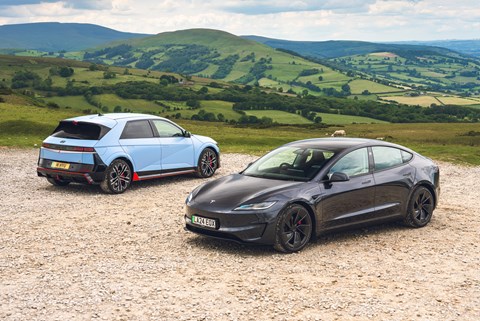
First place
Hyundai Ioniq 5 N
The most fun you can have in an EV, but get used to opening that charging flap. Fun manual option builds on excellent dynamics
Second place
Tesla Model 3 Performance
Much-improved Performance gains speed and quality, but feels more skittish than Hyundai and lacks its sense of fun. If the Ioniq’s range is a concern, this is your car.